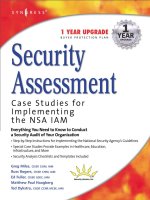Tài liệu Security Protocols: They’re so NOT Easy! pdf
Bạn đang xem bản rút gọn của tài liệu. Xem và tải ngay bản đầy đủ của tài liệu tại đây (224.44 KB, 30 trang )
Security Protocols: They’re so NOT
Security Protocols: They’re so NOT
Easy!
Easy!
Lecture Motivation
Lecture Motivation
In the last lecture we looked at some high-level descriptions of
key distribution and agreement schemes.
These protocols cannot be used as they were stated.
In implementation of the actual protocol, there are many
situations one should be careful of.
In this lecture, we will look at some common protocol failures
that arise when trying to implement security protocols
We will then look at some specific examples of security
protocols
Lecture Outline
Lecture Outline
Some stories from the Dark Side…
Design Principles for building security protocols
Key tools for building robust security protocols
–
Naming
–
Encryption
–
Signing
–
Timestamps and nonces
Examples as we go…
–
Wide-Mouthed Frog
–
Denning-Sacco
–
Woo-Lam
–
Needham-Schroeder
We’ll end with a look at Kerberos
Tales from the Dark Side of Security…
Tales from the Dark Side of Security…
Prepayment in Electricity Meter Systems:
–
Present a (purchased) digital token to a power meter.
–
Digital token would convey an ID so it could not be duplicated or
forged…
–
Problem was that the rate information was not protected
Bank Fraud:
–
A bank would allow customers to present a bank card which had a
PIN code encrypted and stored on the magnetic strip
–
Teller had a copy of the encryption key and could check the PINs.
–
Flaw in design: adversary could alter the account number on the
card to someone else’s, while using his own PIN number… he
would check out ok… but the money would be drawn from
someone else’s account!
–
Flaw in design: PIN number was not connected to account #.
Tales from the Dark Side of Security, pg. 2
Tales from the Dark Side of Security, pg. 2
Pay-Per-View TV Hacks:
–
Decoders are personalized with a smart card. Smart card cannot
decrypt bulk content, so the bulk decryption is done on the
decoder.
–
Many decoders have a microcontroller which passes messages
between the cryptoprocessor and the smart card
–
Attackers can go in and modify or replace the microcontroller, or
can introduce a PC between the decoder and the card in order to
manipulate messages exchanged.
–
Kentucky Fried Chip hack:
When a customer stops paying subscription, the system sends
a message to the decoder to disable the card.
The KFC hack replaced the microcontroller with a a version
that would block this message.
It was able to do this because the system message was sent in
the clear!
Caveat Cryptor: Designer Beware!
Caveat Cryptor: Designer Beware!
The lesson learned from this last story is: The adversary can be
very powerful and clever!
We must assume that the adversary has complete control over
the network…
–
Be paranoid! Alice should not blindly trust what she is getting
from “Bob”! And vice-versa!
–
If we can build a system that we trust in this Seriously Caustic
environment, then we can trust it in more general (day-to-day)
computing scenarios
So, who are the entities?
–
Alice and Bob may be users, or may be smart cards, or devices
–
Eve can be the compromised decoder, or the network, or a hacker
–
When needed, Trent will be a trusted third party server
Security is not easy…
Security is not easy…
Building secure systems and protocols is not easy.
In general, its not an easy matter to prove that some protocol is indefinitely
secure.
–
Denning-Sacco protocol took 12 years for a protocol failure to be
exposed
–
Needham-Schroeder survived for 17 years before a man-in-the-middle
attack was found
Attacks of today must always be considered when building systems
–
Attacks of tomorrow aren’t known yet…
–
That’s the challenge!
What can we do?
–
Formal verification logics?
–
Basic design guidelines?
Basic Guidelines
Basic Guidelines
Needham has given several guidelines for building secure systems
1. Be clear of security goals and assumptions
2. When using encryption, know why you are using it (secrecy? Authenticity?
Binding? PRNG?) . Encryption is not security!
3. Be careful about temporal associations
4. Don’t assume the identity of a participant can be excluded from a message.
Generally, it should be explicitly included in a message!
5. Have redundancy in your message!
6. Know the properties and weaknesses of the cryptographic protocols you are
using.
7. Signatures do not imply that the signer knows what the message is that he is
signing!
8. Don’t trust others to keep their secrets secret!
9. When responding to queries, be careful about encrypting, decrypting, or
signing. You might be used as an oracle by an adversary!
10. Decryption is not the same as digital signatures- they have different
purposes!
11. Distinguish between different runs of the protocol!
Other Considerations
Other Considerations
KISS (Keep It Simple Stupid) is often desirable from an
engineering point of view…
–
Its generally BAD from a security point of view!
–
Removing some data fields because they seem like they can be
inferred (and thus shorten the message) can result in severe
protocol failures!
Formal methods are helpful, but are at still at a young stage of
development
–
For information on formal models, look Kailar’s logic in R. Kailar,
“Reasoning about accountability in protocols for electronic
commerce,” 1995 IEEE Symposium on Security and Privacy
Why these rules? How to use them?
Why these rules? How to use them?
The previous two slides gave guidelines, but not did not say
why we should follow these guidelines.
We are going to look at several examples of protocols that, at
first glance, looked OK… but flaws were uncovered later.
These examples will illustrate why we need to be careful, and
why these rules are important.
In order to carry out these guidelines, we need some tools, so we
will introduce various tools in the process to fix these protocols.
Wide-Mouthed Frog Protocol
Wide-Mouthed Frog Protocol
The Wide-Mouthed Frog Protocol is one of the simplest symmetric key
management protocols involving a trusted third party (Trent = T)
Alice chooses a session key to communicate with Bob and has Trent
transfer it to Bob securely.
The parameter t
A
is a timestamp supplied by Alice, while t
T
is given by
Trent. Bob will accept K
AB
as fresh if it arrives in a certain window of
time.
The WMF protocol fails because Trent updates the timestamp
If Trent does not keep a list of all recent keys and timestamps, Eve can
use Trent as an Oracle!
[ ]
[ ]
ABATK
ABBAK
K,ID,tE:BT
K,ID,tE:TA
BT
AT
→
→
Failure in the Wide-Mouthed Frog Protocol
Failure in the Wide-Mouthed Frog Protocol
Let’s see how Eve can make Trent act as an Oracle…
1. After seeing one exchange of the protocol, Eve could pretend to be
Bob wanting to share a key with Alice
2. Eve would send Trent the replay
3. Trent would send back , where is a new
timestamp. Alice would think this is an OK message since it came
from Trent.
4. Eve could then pretend to be Alice and get
5. And so on…
Effect: The key K
AB
is kept indefinitely alive
To fix: You need to be explicitly clear about how you keep track of
temporal succession (did you see this key before?)
[ ]
ABATK
K,ID,tE
BT
'
T
t
[ ]
ABB
'
TK
K,ID,tE
AT
[ ]
ABA
''
TK
K,ID,tE
BT
Denning-Sacco Public Key Exchange
Denning-Sacco Public Key Exchange
Distributing public keys is not as simple as announcing public keys…
As we saw earlier, certificates help… but its not easy giving out
certificates either!
In 1982, Denning and Sacco proposed one of the first public key
protocols for distributing shared (symmetric) encryption keys using
certificates
The protocol:
Here, we use the symbol to represent Alice’s private key.
First two messages gives Alice the certificates
The third message: Alice sends a key to be shared and a timestamp.
The message is encrypted for secrecy and authenticity
[ ]
[ ]
ABA
K
K
BA
K,tEE,CB,CA:BA
CB,CA:AT
ID,ID:TA
1
A
B
−
→
→
→
1
A
K
−
Failure in Denning-Sacco
Failure in Denning-Sacco
A big flaw was found in 1994 by Abadi in the Denning-Sacco protocol
The problem comes down to: In the last message, Bob should have a
guarantee that this message was intended for him.
Although it looks like it does (it uses K
b
), it does not.
Abadi realized that step 3, Bob can masquerade as Alice, and use this to fool
Charles!
Here’s how:
1. Bob gets Charles’ certificate CC.
2. Bob creates a new message 3’ to send to Charles:
Now, Charles will think this message came from Alice and will use K
AB
as the
key. Since Bob knows K
AB
, Bob can read Charles’ messages!
[ ]
[ ]
ABA
K
K
K,tEE,CC,CA:CB
1
A
C
−
→
Failure in Denning-Sacco, pg. 2
Failure in Denning-Sacco, pg. 2
What was wrong with Denning-Sacco?
The identities of who message 3 came from and was intended for was not
clear.
Thus, the guideline: Names should be explicitly stated in the protocol
messages!
A better choice for the third message would have been:
Important Caveat: Make certain you only use this format of the message only
once between Alice, Bob, and Trent!
–
That is, make certain this message cannot be reused later in the protocol,
or in another protocol!
–
It is possible to use one protocol against another!
[ ]
[ ]
ABABA
K
K
K,t,ID,IDEE,CB,CA:CB
1
A
C
−
→
Woo-Lam Authentication Protocol
Woo-Lam Authentication Protocol
Woo and Lam presented an authentication protocol using symmetric
cryptography in which Alice tries to prove her identity to Bob, yet she
does not share a key with Bob but instead with Trent
The protocol:
The first step, Alice claims her identity.
Step 2: Bob provides a nonce challenge. Step 3: Alice returns this
challenge encrypted using K
AT
.
Step 4: Bob passes this to Trent for translation. Step 5: Trent translates
and returns the nonce. Bob verifies the nonce.
[ ]
[ ]
[ ]
[ ]
BK
BKAK
BK
B
A
NE:BT
NE,IDE:TB
NE:BA
N:AB
ID:BA
BT
ATBT
AT
→
→
→
→
→
Woo-Lam Protocol Failure
Woo-Lam Protocol Failure
There is a protocol failure in Woo-Lam that comes from the fact that
the connection between Bob-to-Trent’s message and Trent-to-Bob’s
message is not strong enough
The only “connection” comes from the fact that message 4 and
message 5 happen shortly one after another.
This weak association can be used in an attack where Eve
impersonates Alice:
1. Eve tries to authenticate herself to Bob (or Bob’s computer) at about
the same time as Alice.
2. Trent will respond to each at roughly the same time.
3. Eve intercepts both responses, and swaps them.
Let us see how in a step-by-step description
Woo-Lam Protocol Failure
Woo-Lam Protocol Failure
The step-by-step impersonation
attack:
[ ]
[ ]
[ ]
[ ]
[ ]
[ ]
[ ]
[ ]
→
→
→
→
→
→
→
→
→
→
BK
''
BK
BKEK
BKAK
BK
BK
'
B
B
E
A
NE:BT
NE:BT
NE,IDE:TB
NE,IDE:TB
NE:BE
NE:BE
N:EB
N:AB
ID:BE
ID:BE
BT
BT
ETBT
ETBT
ET
ET
Step 1: Eve tells Bob that both Alice and Eve
want to establish a connection
Step 2: Bob replies with two challenges. Eve
gets one as usual, and intercepts the other!
Step 3: Eve responds to both challenges. Here,
Eve can send anything for Alice, but she swaps
Alice’s correct response for Eve’s response to
send to Bob!
Step 4: Bob contacts Trent with two responses.
Step 5: Trent responds. One is junk. The other
is the challenge meant for Alice.
Bob gets back the challenge he issued to Alice
and then thinks Alice is present (authenticated).
Some fixes to Woo-Lam
Some fixes to Woo-Lam
The problem was (again) that the last message was not tied to the
identity of who it corresponded to.
One simple fix is to make message 5 include Alice’s identity:
So, Trent tells Bob who the response corresponds to. Then, Bob will be
able to tell that message 5’ does not correspond to Eve’s nonce!
One problem is that Trent does not know what host that Alice is trying
to log onto. Eve might get Alice to log onto Eve’s computer. Then Eve
can start a logon in Alice’s name to Bob’s machine. Eve then gets
Alice to answer Bob’s challenges to Eve…
The fix:
[ ]
BAK
N,IDE:BT
BT
→
[ ]
[ ]
[ ]
[ ]
BAK
BBKKA
BBK
B
A
N,IDE:BT
N,IDEE,ID:TB
N,IDE:BA
N:AB
ID:BA
BT
ATBT
AT
→
→
→
→
→
Needham-Schroeder
Needham-Schroeder
We now look at the Needham-Schroeder
authenticated key exchange protocol
The protocol
[ ]
[ ]
[ ]
[ ]
[ ]
1NE:BA
NE:AB
K,IDE:BA
K,IDE,K,NID,IDE:AT
N,ID,ID:TA
2K
2K
SAK
SAKS1BAK
1BA
S
S
B
BA
−→
→
→
→
→
Step 1: Alice tells Trent what
she is requesting
Step 2: Trent gives Alice the
session key and gives Alice a
package to deliver to Bob.
Step 3: Bob can get the
session key, and the identity
of who he is talking with
(verified because it came
from Trent).
Step 4: Bob sends Alice a
challenge
Step 5: Alice answers
challenge
An attack on Needham-Schroeder
An attack on Needham-Schroeder
In 1981, Denning and Sacco showed if
the session key is compromised, then
Eve can make Bob think that he is
communicating with Alice.
Assume the NS protocol took place, and
that Eve has recorded the first 3 steps.
Also, assume that Eve has obtained the
session key.
The following steps subvert NS:
[ ]
[ ]
[ ]
1NE:BE
NE:AB
K,IDE:BE
3K
3K
SAK
S
S
B
−→
→
→
Step 1: Eve replays step 3
from NS as if she were Alice.
Step 2: Bob gets this message
and issues a challenge to
Alice in the form of a new
nonce. This challenge is
intercepted by Eve.
Step 3: Since Eve knows the
session key, she can respond
correctly to the challenge.
The basic problem: messages
can be replayed once the
session key is compromised!
Time, Time! Who’s got the Time?
Time, Time! Who’s got the Time?
The clock plays an important role in many security protocols.
–
Time provides an ordering of events
–
Time and timestamps help provide measures of freshness to protocols
Having reliable and synchronized clocks is an important challenge in
building secure and trusted systems.
–
We can’t simply use the normal clock time… an enemy may manipulate
the clock, or the clock may fail
Setting the clock back:
–
Perhaps a user had access to some data in the past, but that access has
expired now. Setting the clock back might allow the user to access data
for which his access privileges had expired.
–
Expired certificates are fresh again…
–
Automated tasks may be forced to repeat by repeatedly setting the clock
back after the task is executed
Time, Time! Who’s got the Time? Pg. 2
Time, Time! Who’s got the Time? Pg. 2
Stop the time:
–
An adversary may freeze the clock and thereby cause audit logs to
become ambiguous
–
Actions, such as refreshes, no longer happen.
Setting the clock ahead:
–
Denial of service attacks are possible: Certificates automatically
expire!
–
Many situations involve release of confidential information at a
specified time in the future… moving the clock ahead forces the
release of this information!
–
In auction-based systems, if you can alter the auction-system clock
forward, you can deny many rivals the opportunity to get last-bids
in.
Time, Time! Who’s got the Time? Pg. 3
Time, Time! Who’s got the Time? Pg. 3
Many of the fixes for Needham-Schroeder involve the use of timestamps
(notably: Denning and Sacco have a timestamped version of NS, and
Kerberos is a modification of NS).
–
Denning and Sacco point out that slow clocks allow for replay attacks
–
Gong points out that fast clocks can be used to replay requests (If Alice
has a fast clock, and Eve knows it, then Eve can reuse her request at the
correct time).
Generally, protocols that rely on synchronized clocks must also be
accompanied by protocols that access time servers.
–
These time protocols cannot rely on synchronized clocks and instead
must use nonces.
Reiter’s time protocol:
Time is accepted if response is quick.
[ ]
ATK
AA
N,tE:AT
N,ID:TA
AT
→
→
Kerberos
Kerberos
Kerberos is a real-world implementation of a symmetric cryptographic
protocol that provides authentication and security during key exchange
between users in a network.
It is, basically, a real-world implementation of Needham-Schroeder with
some appropriate fixes.
Kerberos grew out of MIT’s Project Athena, whose purpose was to integrate
a network of computer workstations and allow students to access files easily
from anywhere on the network.
Kerberos is based upon a client-server model.
Actors:
–
Cliff: The Client, wants to use a service
–
Serge: The service server
–
Trent: A Trusted Authority (also called an Authentication Server)
–
Grant: Ticket Granting Server
There are two versions of Kerberos in use (Version 4 and Version 5). We
will discuss the basics common to them both.









